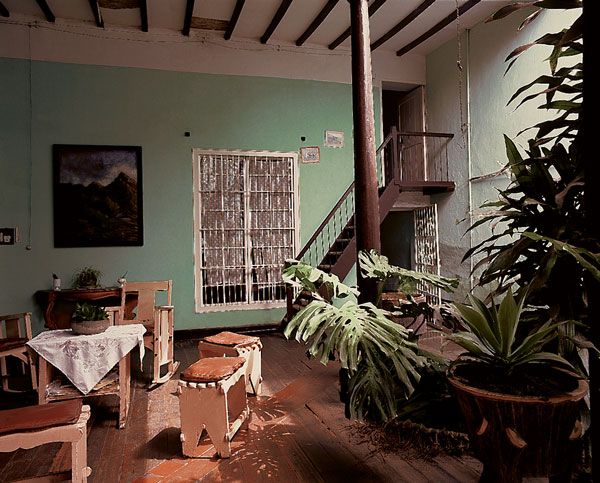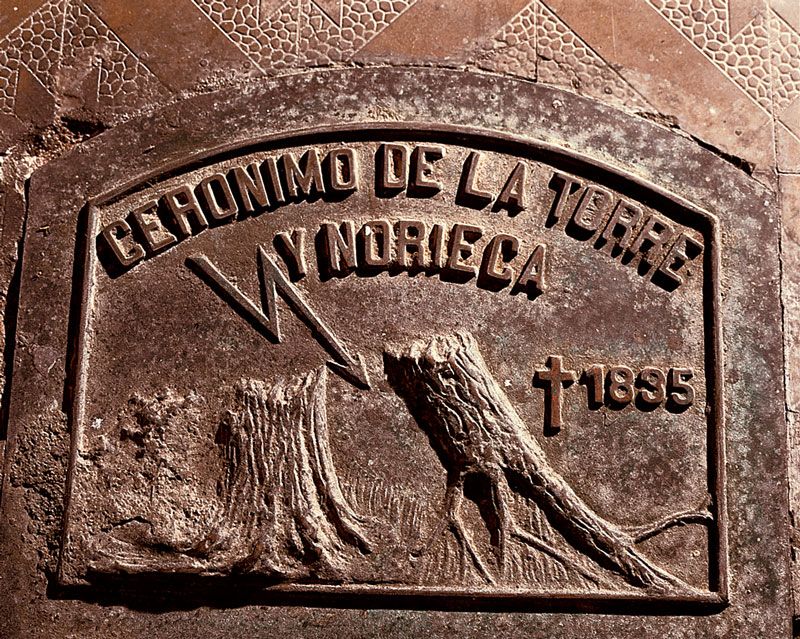
Back verandah of the family house in Trujillo. According to family tradition, Mr. Víctor Raúl Haya de la Torre gave his first childhood speeches on the stoop at the end of these steps.
But much more than the theater and his first inclinations towards drawing, Macedonio was bowled over by the violin. Not long after his first systematic lessons with his teacher, Manuel Tejada, who was a music professor at the Colegio Nacional de San Juan, Macedonio became a tireless practitioner of this instrument. When he had dominated the violin sufficiently enough to interpret classical compositions with resolution and dedication, he organized evenings at his home to play his renditions. These impetuous and natural gifts pushed Macedonio towards the arts. He concluded his secondary studies in 1911, and began his university work the next year at the University of Trujillo. His regular courses at the school of arts affected him less than his encounters with a cluster of young men, all eager for knowledge, in the cloisters of an old Jesuit convent. It was here that Macedonio built his friendships with César Vallejo, Federico Esquerre, Oscar Imaña, Antenor Orrego, Eloy Espinoza, Juan Espejo Asturrizaga, Alcides Spelucín, Carlos Manuel Cox, his cousins, Víctor Raúl y Agustín Haya de la Torre, Álvaro Pinillos and many more. Each one of these very young students possessed an enormous potential for poetry, essays, law, politics and philosophy. It was during these years- 1912, 1913 and 1914- that Macedonio affirmed his ties with his own generation in Trujillo, creating intellectual and emotional bonds that would remain intact -under multiple circumstances and across various latitudes- for a lifetime.
While the majority of the aforementioned individuals followed university studies in the northern capital, Macedonio decided to continue his courses in Lima at the Universidad Mayor de San Marcos in 1913 and 1914. He returned to his native city during the summer vacations. At 20, he was neither the boy king nor his father’s little boy. Now far from his family’s influence, his passion for art and adventure flourished even more. It was as such that Macedonio, tired of the courses he was obligated to take, opted for a definitive and radical decision. On the day that he was scheduled to take some exams, he reflected on the following: instead of appearing before the panel slated to administer his exam in a classroom across from the University’s main entrance, he would do two or three laps around the fountain located on the main patio. He did the last lap with his eyes closed so that, having gone around the water tank, he would stop at some point and open his eyes: if he found himself in front of the room where the panel was waiting, he would take his test and finish his studies. However, if he landed in front of the door leading to the street... he would forget about the University all together. We all know how this story ended.

Back verandah of the family house in Trujillo. According to family tradition, Mr. Víctor Raúl Haya de la Torre gave his first childhood speeches on the stoop at the end of these steps.
Tombstone of Gerónimo de la Torre y Noriega, Macedonio de la Torre’s ancestor, in the Church of La Merced de Trujillo.

It was with this decision that Macedonio initiated his eventful globetrotting; he had yet to be resolutely touched by a passion for painting. He wanted to see the world, to touch and feel new horizons; so, he programmed a trip south, accompanied by Alberto Sotero and Eulogio Cedrón. Sailing on the “Aisen” steamer, these young men hoped to reach Buenos Aires. However, the travelers´ insufficient funds made it so they could only but tickets as far as the port at Canete known as Cerro Azul. Nevertheless, a sailor’s complicity permitted them to reach Valparaíso for a modest sum. However, the voyage did not end here; Cedrón and Macedonio decided to embark upon a new and very unusual adventure: going on foot…all the way to Buenos Aires. This is how it went: 320 kilometers in eleven days, subsisting on a diet of crackers alone. What would Father Goullon, his ball-playing teacher of track and field, have said about his diligent disciple? Macedonio remained in the Argentine capital for almost two years, from 1915 to 1917, surviving by engaging in the most exotic of trades, the most picturesque of which was highly suitable to his physical type- brown skin, pointy features, dark-eyes, black hair and beard all on a slight and bony frame- because his employer, the owner of a café in the Plaza de la Constitución, billed Macedonio as …. the gypsy violinist. The former student from San Marcos, dressed as a tzigane and lightly made up to fool the more observant, dedicated eight hours a day to entertaining customers with the ample repertory that any legitimate gypsy was expected to master.
This long stay in Buenos Aires brought him into contact with a group of artists from the Argentine district known as La Boca, the most famous of whom included Benito Quinquela Martín and Orlando Stagnano. It is possible that the colorism of the former and his preference for scenes from Buenos Aires impressed the novice painter from Trujillo. Macedonio systematically visited the ateliers of artists who received, virtually immediately, the plastic proposals practiced on the European continent. This must have planted a profound desire within the artist´s soul to visit the Old World, given that the Atlantic city in which he lived was permanently connected to Europe through the waves of immigrants, particularly Spanish and Italian, that passed through its port. The individuals that disembarked here had left behind a continent shaken by World War I and its aftermath of destruction and misery.
Macedonio´s made his return to Peru in 1917 through Northern Argentina and Bolivia. He entered the country at the port of Arica, where he made his first individual exhibition of works he had painted in Buenos Aires. The young painter returned to his native country enriched by his initial international experiences, which had pushed him to explore other horizons and eventually decide for a permanent profession in painting. From this point on, painting would become his all-encompassing and predominant inclination, although he would later be attracted by sculpture, whose basic principles he had learned in Buenos Aires at Orlando Stagnaro´s atelier.